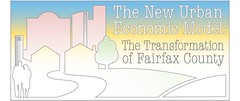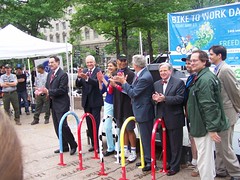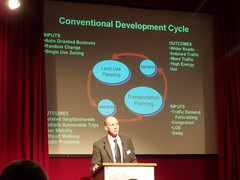How to Kill the Center Cities, particularly DC: Phase 3
Phase 1: automobility, suburbanization and outmigration, especially after World War II, along with financing and mortgage policies that favored suburban places and homogeneous ("whites only") populations.
Phase 2: a further extension of this concept, but along a more exciting, more concentrated (compact) development model, embracing transit, or at the very least, creating environments where you can park and then walk. Arlington does this along the Wilson Blvd. corridor. Federal Realty Investment Trust has done this in Bethesda (Bethesda Row) and Shirlington, among other places. And there are examples of this in other cities, such as Universal City Walk in Santa Monica (Jon Jerde) or The Grove in-city lifestyle center adjacent to the Los Angeles Farmers Market in the mid-Wilshire district of Los Angeles.
Phase 3, or the next generation of this has to do with the further extension and intensification of the learning from phase 2. In other words, more compact development that is less dependent on automobility.

A colleague sent me a notice about a conference that the Fairfax County Economic Development Authority is holding next month, "The New Urban Economic Model: The Transformation of Fairfax County,” which the organization describes as:
a thought-provoking conference exploring how forward-thinking business communities and companies are rising to the challenges and opportunities created by urbanization. How do communities navigate such a transformation while maintaining their position as desirable locations for business— with a strong economy and higher quality of life?
As I mentioned last week, a couple weeks ago I went to a similar kind of thing for the area around White Flint/Rockville Pike. I went because of Ian Lockwood, from Glatting Jackson, an excellent planning firm and of course, Chris Zimmerman.
Almost 9 years ago (September 2000), at the National Building Museum, I saw a presentation by Bob Brosnan, planning director of Arlington County, and I went up to him after and said he should retitle his presentation "how to kill DC." Not that you can blame DC's failures to remain competitive fully, on the suburbs.... but this reinforces my general thinking about this that:
1. You can't stay the same and not expect the best of your competition to remain static;
2. It doesn't matter if DC does better than Baltimore, Pittsburgh, and Philadelphia, because it competes with Arlington, Alexandria, Tysons Corner, and Montgomery County (I-270 corridor, Rockville Pike, Bethesda, Silver Spring).
It bothers me to no end that DC still has a hard time working to extend urbanism and think creatively, while the suburbs--Arlington County especially--understand that their future is in being more "urban" not more suburban.
So DC needs to seize every opportunity to strengthen urbanism, of the streetscape, of new anchors and activity centers being located in extant commercial districts, rather than on newly developed spaces, adding housing to commercial districts where it can be accommodated, on walking, bicycling, and transit, and on looking at new ways to harvest urban opportunities to make the city truly world class.
For example, I know that it's a Mayor's "job" to be a cheerleader, and DC has made great strides, but to call the city the best place in the world to bicycle, as Mayor Fenty did during his slot at speaking at last Friday's "Bike to Work Day" celebration in Freedom Plaza is a joke.

Luminaries, including the former mayor of Zurich, DC City Council Chairman Vincent Gray, Mayor Fenty and the Ambassador of Switzerland, Urs Ziswiler, in front of art-decorated bicycle racks donated to DC by Switzerland, as part of their sponsorship of Bike to Work Day, at Bike to Work Day, Freedom Plaza, DC, 5/15/2009.
That doesn't mean that DC hasn't made great strides with improving the environment for bicycling--the city has, and the DC Department of Transportation, Jim Sebastian, the pedestrian and bicycling coordinator there, have moved the city significantly forward, incrementally sure, and not perfectly, but forward--but it is still a fact that bicyclists are resented by most drivers and that riding on many DC streets is dangerous, and that the city has a long long way to go to "Making Cycling Irresistible," the title of a paper by John Pucher which discusses the superlative world class bicycling environments in several European Cities.
I just don't get the feeling that the top elected officials (with a couple exceptions) truly get the fact that there is a significant disconnect between the words and the deeds.

Bike Switzerland: Building a Nation of Bicyclists. Presentation board, Bike to Work Day, 5/15/2009, Freedom Plaza, DC.
Meanwhile, DC's best competitors: Arlington County; Alexandria; Tysons Corner; and Montgomery County (I-270 corridor, Bethesda, Rockville Pike, Silver Spring) [I repeat this, deliberately]; continue to improve, and focus less energy on talk and cheerleading, and more time on doing.
Presentation slides, Healthy Development vs. Conventional Development, presentation by Ian Lockwood, Smart Growth presentation on Rockville Pike, Friends of White Flint.


Labels: land use planning, sustainable land use and resource planning, transportation planning, urban design/placemaking, urban vs. suburban



0 Comments:
Post a Comment
<< Home